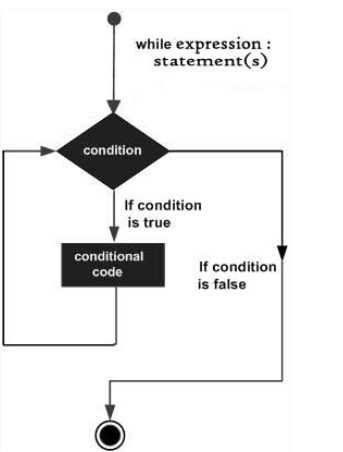while语句用于循环执行程序
一、概念:
条件循环是指:一个结构,导致一个程序要重复一定次数,当条件变为假,则循环结束。
二、语法:

1 while 条件: 2 3 # 循环体 4 5 # 如果条件为真,那么循环体则执行 6 # 如果条件为假,那么循环体不执行
执行语句可以是
a、单个语句或语句块。
b、判断条件是以任何表达式。
c、任何非零、或非空(null)的值均为True。
当判断条件为false时,循环结束:
执行流程图:

while循环表达式(s):
1、通过条件判断,如果表达式为true。
2、开始执行条件语句。
3、开始continue,break的循环。
4、如果条件判断为false,则退出循环体。

1 #!/usr/bin/env python 2 # -*- coding:utf8 -*- 3 4 count = 0 5 while (count < 9): 6 print(‘The count is:‘), count 7 count = count + 1 8 print("Good bye!") 9 10 11 输出结果: 12 The count is: 0 13 The count is: 1 14 The count is: 2 15 The count is: 3 16 The count is: 4 17 The count is: 5 18 The count is: 6 19 The count is: 7 20 The count is: 8 21 Good bye!
break和continue的用法
while 语句时还有另外两个重要的命令 continue,break 来跳过循环:
continue 用于跳过该次循环
break 则是用于退出循环
此外"判断条件"还可以是个常值,表示循环必定成立,具体用法如下:

1 i = 1 2 while i < 10: 3 i += 1 4 if i%2 > 0: # 非双数时跳过输出 5 continue 6 print (i) # 输出双数2、4、6、8、10 7 8 9 i = 1 10 while 1: # 循环条件为1必定成立 11 print (i) # 输出1~10 12 i += 1 13 if i > 10: # 当i大于10时跳出循环 14 break
无限循环

1 #!/usr/bin/python 2 #coding=utf-8 3 4 var = 1 5 6 while var == 1 : # 该条件永远为true,循环将无限执行下去 7 num = raw_input("Enter a number :") #表示需要界面输入值,用于交互print "You entered: ", num #num是上面的变量,表示输人值在输出 8 9 print ("Good bye!")
注意:以上的无限循环你可以使用 CTRL+C 来中断循环。(循环无止境,直到内存撑爆,会导致系统雪崩!)
while循环中使用else语句
while.....else表示这样的意思:
1、while中的语句和普通的没有区别。
2、else中的语句会在循环正常执行完(即while不是通过break跳出终端的)的情况下执行。
3、当while 循环执行成功后,另外在执行附加条件else。

1 #!/usr/bin/python 2 3 count = 0 4 while count < 5: 5 print(count, "is less than 5") 6 count = count + 1 7 else : 8 print(count,"is not less than 5") 9 10 11 输出结果: 12 0 is less than 5 13 1 is less than 5 14 2 is less than 5 15 3 is less than 5 16 4 is less than 5 17 5 is not less than 5
简单语句组
类似if语句的语法,如果你的while循环体中只有一条语句,你可以将该语句与while写在同一行中, 如下所示:

1 #!/usr/bin/python 2 3 flag = 1 4 while (flag): print ‘Given flag is really true!‘ 5 6 7 输出结果: 8 print "Good bye!" 9 10 注意:以上的无限循环你可以使用 CTRL+C 来中断循环。

